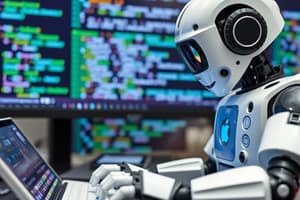Podcast
Questions and Answers
Which of the following best describes an actuator's primary function in a robotic system?
Which of the following best describes an actuator's primary function in a robotic system?
- Generating electrical power
- Moving and controlling a mechanism (correct)
- Analyzing sensory data
- Making decisions based on algorithms
An algorithm is exclusively used in robotics for solving mathematical problems.
An algorithm is exclusively used in robotics for solving mathematical problems.
False (B)
What is the main goal of incorporating artificial intelligence (AI) into machines?
What is the main goal of incorporating artificial intelligence (AI) into machines?
simulating human intelligence
The use of technology to perform tasks with minimal human intervention is known as ______.
The use of technology to perform tasks with minimal human intervention is known as ______.
Match each robot type with its description:
Match each robot type with its description:
What is the significance of 'battery life' in the context of robotics?
What is the significance of 'battery life' in the context of robotics?
The 'chassis' refers to the software and programming that operate the robot.
The 'chassis' refers to the software and programming that operate the robot.
Define 'computer vision' in the field of robotics.
Define 'computer vision' in the field of robotics.
The 'degrees of freedom' of a robot specify the ______ number of independent movements the robot can make.
The 'degrees of freedom' of a robot specify the ______ number of independent movements the robot can make.
What is the primary function of an 'end effector' in a robotic system?
What is the primary function of an 'end effector' in a robotic system?
An 'exoskeleton' is a type of software used to program robots.
An 'exoskeleton' is a type of software used to program robots.
What does the term 'feedback loop' refer to in the context of robotics?
What does the term 'feedback loop' refer to in the context of robotics?
The phenomenon where the fulcrum's position affects the force needed to move an object is the ______ effect.
The phenomenon where the fulcrum's position affects the force needed to move an object is the ______ effect.
Which of these functions does GPS primarily provide for robots?
Which of these functions does GPS primarily provide for robots?
'Kinematics' is the study of a robot's movements including the forces that cause them.
'Kinematics' is the study of a robot's movements including the forces that cause them.
What is the purpose of a 'laser sensor' in robotics?
What is the purpose of a 'laser sensor' in robotics?
The term 'Locomotion' refers to the ______ capability of a robot.
The term 'Locomotion' refers to the ______ capability of a robot.
Match these terms to their definitions:
Match these terms to their definitions:
What does 'SLAM' stand for in the context of robotics?
What does 'SLAM' stand for in the context of robotics?
'Swarm robotics' involves studying individual robots in isolation.
'Swarm robotics' involves studying individual robots in isolation.
Flashcards
Actuator
Actuator
A component responsible for moving and controlling a mechanism or system.
Algorithm
Algorithm
A step-by-step procedure for solving a problem or performing a task.
Artificial Intelligence
Artificial Intelligence
The simulation of human intelligence in machines.
Automation
Automation
Signup and view all the flashcards
Autonomous Robot
Autonomous Robot
Signup and view all the flashcards
Bipedal Robot
Bipedal Robot
Signup and view all the flashcards
Battery Life
Battery Life
Signup and view all the flashcards
Chassis
Chassis
Signup and view all the flashcards
Computer Vision
Computer Vision
Signup and view all the flashcards
Controller
Controller
Signup and view all the flashcards
Degrees of Freedom
Degrees of Freedom
Signup and view all the flashcards
End Effector
End Effector
Signup and view all the flashcards
Embedded System
Embedded System
Signup and view all the flashcards
Exoskeleton
Exoskeleton
Signup and view all the flashcards
Feedback Loop
Feedback Loop
Signup and view all the flashcards
Fulcrum effect
Fulcrum effect
Signup and view all the flashcards
GPS (Global Positioning System)
GPS (Global Positioning System)
Signup and view all the flashcards
Humanoid Robot
Humanoid Robot
Signup and view all the flashcards
Industrial Robot
Industrial Robot
Signup and view all the flashcards
Joint
Joint
Signup and view all the flashcards
Study Notes
- Academic and Technical Communication in English (Level C1) glossary.
Actuator
- A actuator is a component responsible for moving and controlling a mechanism or system.
Algorithm
- An algorithm is a step-by-step procedure for solving a problem or performing a task.
Artificial Intelligence
- Artificial Intelligence is the simulation of human intelligence in machines.
Automation
- Automation is the use of technology to perform tasks with minimal human intervention.
Autonomous Robot
- An autonomous robot operates independently without human control.
Bipedal Robot
- A bipedal robot is designed to walk on two legs.
Battery Life
- Battery life is the duration a robot can function without recharging.
Chassis
- The chassis is the base frame of a robot.
Computer Vision
- Computer Vision is a field of AI that enables machines to interpret images.
Controller
- A controller is a system that manages robot movements.
Degrees of Freedom
- Degrees of freedom represent the number of independent movements a robot has.
End Effector
- An end effector is a device at the end of a robotic arm, such as a gripper or tool.
Embedded System
- An embedded system is a computing system dedicated to specific functions within a larger system.
Exoskeleton
- An exoskeleton is a wearable robotic device that enhances human movement.
Feedback Loop
- A feedback loop is a system that adjusts actions based on received data.
Fulcrum Effect
- The fulcrum effect is the phenomenon where the position of the fulcrum changes the force needed to move an object.
GPS (Global Positioning System)
- GPS determines location for navigation.
Humanoid Robot
- A humanoid robot is designed to resemble and mimic human actions.
Industrial Robot
- An industrial robot is used in manufacturing and industrial applications.
Joint
- A joint is a movable connection in a robot.
Kinematics
- Kinematics is the study of motion without considering forces.
Laser Sensor
- A laser sensor measures distance using laser beams.
Locomotion
- Locomotion is the movement capability of a robot.
Machine Learning
- Machine Learning is an AI approach where computers learn from data without explicit programming.
Manipulator
- A manipulator is a robotic arm that interacts with objects.
Microcontroller
- A microcontroller is a small computer on a single circuit board.
Mobile Robot
- A mobile robot is a robot that moves around in its environment.
Motion Planning
- Motion Planning is the process of determining movements for a robot.
Neural Network
- A neural network is a system modeled after the human brain to recognize patterns.
Obstacle Avoidance
- Obstacle Avoidance is a robot's ability to detect and bypass objects.
Path Planning
- Path Planning is the process of computing an optimal route for a robot.
Payload
- Payload is the maximum weight a robot can carry.
Perception
- Perception is the ability of a robot to interpret sensory data.
Power Supply
- Power Supply is the energy source of a robot.
Programming Language
- Programming Language is used to code robots.
Proximity Sensor
- A proximity sensor detects nearby objects.
Reinforcement Learning
- Reinforcement Learning is an AI training method based on rewards and penalties.
Robotics
- Robotics is the science and technology of designing, building, and using robots.
Self-Driving Car
- A self-driving car is an autonomous vehicle using AI.
Sensor
- A sensor is a device that detects and measures physical properties.
Servomotor
- A servomotor is a motor used for precise control.
Simulation
- Simulation is a virtual representation of a real-world process for testing.
SLAM
- SLAM stands for Simultaneous Localization and Mapping, used for navigation.
Software
- Software comprises programs enabling robots to operate.
Sonar Sensor
- A sonar sensor uses sound waves to detect objects.
Speed Control
- Speed Control regulates a robot’s movement.
Swarm Robotics
- Swarm Robotics is the study of multiple robots working together to complete tasks.
Teleoperation
- Teleoperation involves controlling a robot remotely.
Torque
- Torque is the rotational force in motors.
Trajectory
- Trajectory is the path a robot follows.
Underactuated Robot
- An underactuated robot has fewer controls than movements.
User Interface
- A user interface is how humans interact with robots.
Vision System
- A vision system enables robots to process visual information.
Warehouse Robot
- A warehouse robot is used in logistics automation.
Waypoint Navigation
- Waypoint Navigation involves moving between predefined points.
Wireless Communication
- Wireless Communication is remote data transmission.
AI Ethics
- AI Ethics encompasses moral considerations in robotics.
Cobots
- Cobots are collaborative robots working with humans.
Dexterity
- Dexterity is a robot’s ability to perform precise movements quickly.
Edge Computing
- Edge Computing is processing data closer to the source rather than the cloud.
Hard Robotics
- Hard Robotics refers to traditional rigid robots.
Haptic Feedback
- Haptic Feedback is simulated touch sensations in robots.
IoT (Internet of Things)
- IoT refers to devices interconnected via the internet.
Multi-Agent System
- A multi-agent system involves multiple robots collaborating.
Soft Robotics
- Soft Robotics involves robots made of flexible materials.
Cybernetics
- Cybernetics is the study of communication and control in living organisms and machines.
Force Feedback
- Force Feedback is the sensation of resistance provided by a robotic system.
Kinematic Chain
- A Kinematic Chain is a series of interconnected joints forming a robotic structure.
Redundancy
- Redundancy refers to extra degrees of freedom in robotic systems for flexibility.
Adaptive Control
- Adaptive Control is a control method that adjusts in response to changes in the environment.
Studying That Suits You
Use AI to generate personalized quizzes and flashcards to suit your learning preferences.




